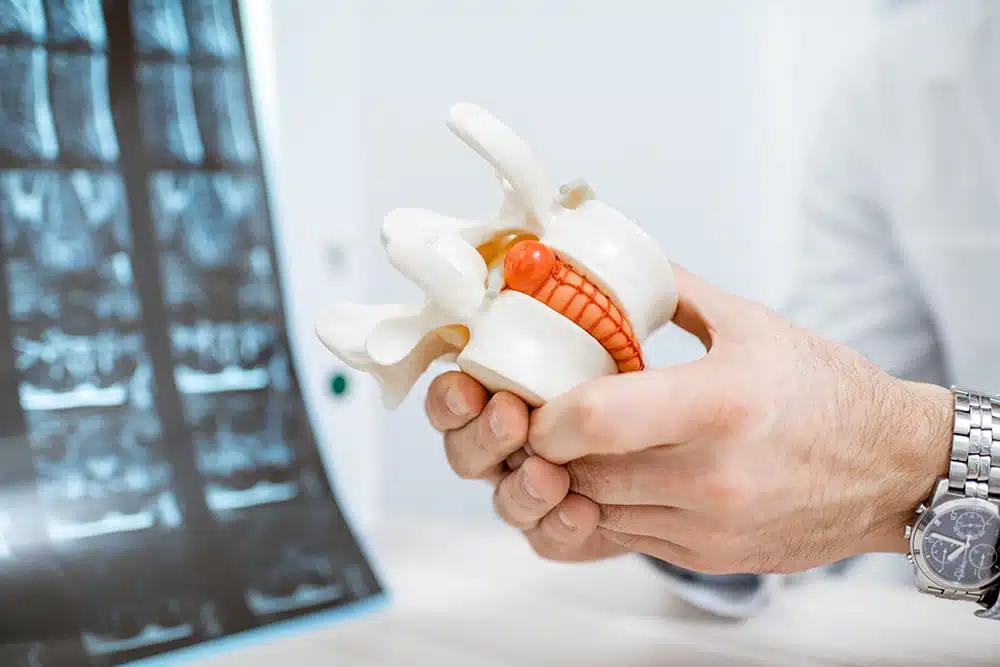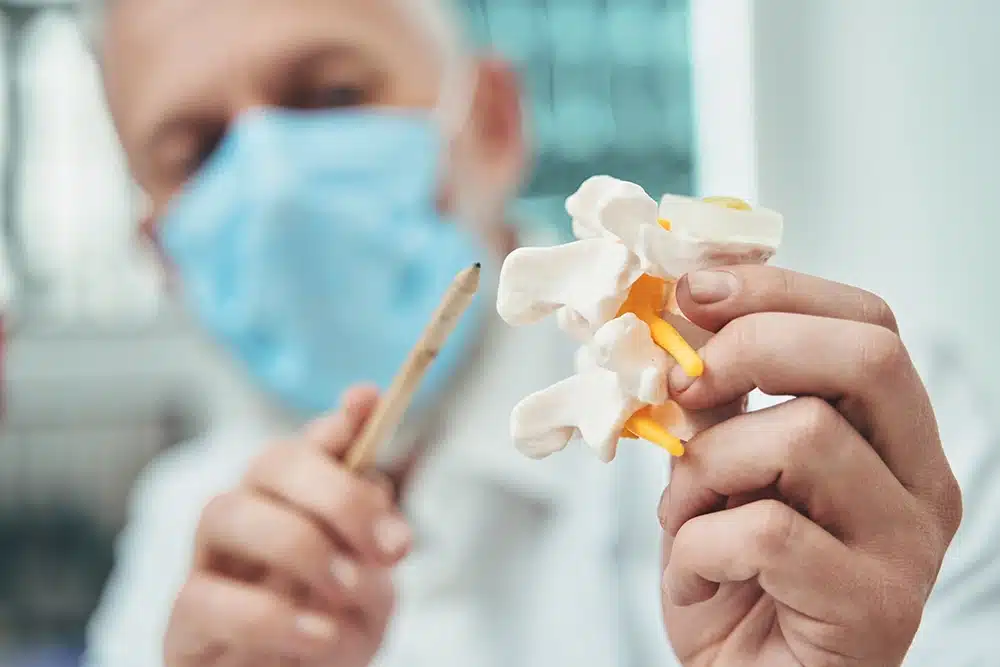
Table of Contents
ToggleIf you have a herniated disc in your back, it can be very painful and can cause long-term problems. Your doctor may recommend surgery to treat your pain and improve function. The most common type of surgery used to treat a herniated disc is microdiscectomy.
To understand why microdiscectomy is so popular, let’s look at what it involves and what the benefits are when compared with non-surgical treatment options for sciatica.
Microdiscectomy involves removing part of the bone overlying an intervertebral disc that has become injured or diseased. This allows the surgeon to access the disc space through an incision made on the side of your back (lateral approach). The surgeon then removes the damaged disc (discectomy) or removes part of it (laser ablation).
What is microdiscectomy?
Microdiscectomy is a minimally invasive surgical procedure that removes a herniated disc fragment and inserts a graft of bone, synthetic material, or cartilage to repair the injured area.
During microdiscectomy, an incision is made in your back to access your spinal canal, and through that incision the surgeon can see directly into your spinal canal and remove any bulging discs or fragments that have been pressing on nerves causing pain or numbness in your leg(s).

The surgery will take place in an operating room. A small incision will be made on your back. The surgeon will then remove disc material that is pressing on a nerve. This material is removed through the incision, which is closed with sutures (stitches).
Surgery to decompress the nerve can be performed to relieve pain and restore function. This procedure may involve removing bone spurs, small pieces of bone that have grown around the nerve, which can help restore range of motion.
The goal of this surgery is to remove the pressure on the nerve, letting it heal and preventing further damage.
Microdiscectomy is a surgical procedure to treat a herniated disc. It is performed under general anesthesia and requires a small incision in the low back. The surgeon makes an opening in the tissue to access and remove part of a disc that has been pushed out through an opening in its outer covering (annulus).
The surgery is a minimally invasive procedure that uses only one or two small incisions, rather than the large incision and general anesthesia required in traditional spine surgery. The surgeon makes an incision on each side of your patient’s spine and removes the bulging disc.
Then he or she will insert a small spacer between each vertebra. Once set in place, this spacer allows for natural growth as well as movement of your patient’s spine as it heals and makes room for new bone deposits.

A microdiscectomy is a minimally invasive procedure that can be performed as an outpatient. This means that you don’t have to stay overnight in the hospital after surgery and can go home the same day.
It’s less invasive than other procedures, meaning there’s less damage to your spine during surgery. You may also recover faster and have fewer complications than with open discectomy (which requires cutting through bone).
Microdiscectomy costs less than other spinal surgeries because it involves less equipment, staff time, and materials needed for the procedure itself.
A microdiscectomy, which separates the vertebrae and removes the herniated disc, could take anywhere from 20 to 60 minutes. For most, it’s about 45 minutes. The entire process will take longer if you have more than one disc removed at once–10-15 minutes per disc removed, on average.
If you have multiple herniated discs and need to have them removed as well as a spinal fusion, the surgery time could be doubled or tripled.
The recovery time for a microdiscectomy surgery depends on the type of procedure you have and your age. In general, however, patients who undergo a microdiscectomy can expect to be out of work for about three weeks. After that, light duty work is okay and gradually things will get better.
You should talk with your doctor about specific recommendations for your own case and follow their advice closely during this time period. The goal is to avoid complications such as infections or blood clots that might require additional surgery or hospitalization.
Microdiscectomy is a minimally invasive procedure that doesn’t require incisions or anesthesia. You will feel no pain during the surgery itself, and recovery may involve just taking some pain relievers after leaving the hospital or surgical center.
If you have sciatica, a herniated disc or disc bulge and have tried other treatments but are not getting the relief you need, then microdiscectomy may be an option for you. The procedure involves removing part of the damaged disc to relieve pressure on your spinal cord or nerve root.
A microdiscectomy is often recommended if other treatments such as medication and physical therapy haven’t helped reduce your pain. It’s also used when there’s no sign of nerve damage but surgery is needed because:
The operation is also an option if you’ve already tried other treatments but haven’t seen any improvement. If a microdiscectomy is recommended for you, your doctor may recommend that you try some other non-surgical treatments first.
When you are experiencing pain in your lower back, it’s time to see a doctor. If the pain is severe and debilitating, it may be best to schedule an appointment with a spinal surgeon as soon as possible. You should also see a spine specialist if:
You have severe pain that doesn’t go away with rest or other treatments. Read more compelling reasons why you might need spine surgery here.
You may be wondering if microdiscectomy is a safe and effective procedure. The answer is yes! Microdiscectomy has been shown to have a high success rate when it comes to treating herniated discs, especially in experienced hands.
It’s important that your surgeon has experience performing this type of surgery so that they can give you the best possible outcomes from your operation.
If you are considering undergoing spinal surgery for herniated discs, microdiscectomy may be right for you. This minimally invasive procedure offers many benefits over traditional open surgeries such as having less pain after surgery, shorter recovery time, less blood loss during surgery (and therefore fewer complications), and faster return-to-normal activities like work or exercise after recovering from microdiscectomy.

If the disc has already herniated a second time, microdiscectomy may not be as successful in relieving your symptoms. This is because discs are more likely to re-herniate after they have done so once before.
The amount of material left after the first herniation will also play a role in whether or not your surgeon recommends you undergo microdiscectomy surgery again. If there is minimal residual nucleus pulposus (the jelly-like center of an intervertebral disc) left behind after your initial diagnosis and treatment, then it’s possible that another procedure could be performed if needed later on down the line — but this isn’t always necessary or even recommended by doctors who specialize in treating spinal disorders like herniated discs with minimally invasive procedures like microdiscectomy surgeries.
If your surgeon believes that there is still enough disc material left behind after your initial diagnosis and treatment, then he or she may not recommend microdiscectomy surgery again. This is because there is a chance that another procedure could cause further damage to the spinal cord.
If you have a herniated disc that is causing you pain, microdiscectomy may be an option for treatment. This surgery has proven to be very effective in relieving pain and improving mobility.
However, careful consideration of all of the pros and cons should precede any decision to pursue this procedure because it can result in further damage to the disc.
GET IN TOUCH +
285 Sills Road
Building 5-6, Suite E
East Patchogue, NY 11772
(631) 475-5511
184 N. Belle Mead Road
East Setauket, NY 11733
(631) 675-6226
GET IN TOUCH +
285 Sills Road
Building 5-6, Suite E
East Patchogue, NY 11772
(631) 475-5511
184 N. Belle Mead Road
East Setauket, NY 11733
(631) 675-6226
SUBSCRIBE TO OUR NEWSLETTER +
Send us a Google review. Click this link and let us know how we did!
Review us on Yelp too.